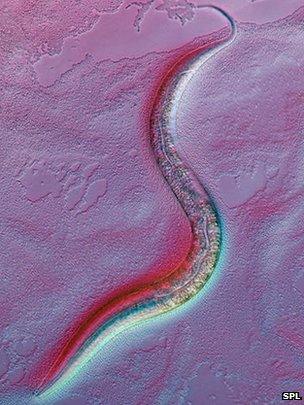Worm lifetime 'longer in space'
- Published

Spacefaring worms undergo genetic changes associated with longer lives in their Earth-bound cousins, research has shown.
A number of <italic>Caenorhabditis elegans</italic> worms were carried aboard a mission to the International Space Station (ISS) and brought back for study.
Researchers found reduced activity of five genes in the worms that, when suppressed in the species on Earth, lead to longer lifetimes.
The work <link> <caption>appears in Scientific Reports</caption> <url href="http://www.nature.com/srep/2012/120705/srep00487/full/srep00487.html" platform="highweb"/> </link> .
The nematode <italic>C. elegans</italic> is among the world's most-studied animals.
They have been routinely taken as cargo on space missions to study in a simple organism the biological changes that future human spacefarers may face; the worms even <link> <firstCreated>2003-05-01T13:31:39+00:00</firstCreated> <lastUpdated>2003-05-01T13:31:39+00:00</lastUpdated> <caption>survived the space shuttle Columbia disaster in 2003</caption> <url href="http://news.bbc.co.uk/1/hi/sci/tech/2992123.stm" platform="highweb"/> <url href="http://news.bbc.co.uk/1/mobile/sci/tech/2992123.stm" platform="enhancedmobile"/> </link> .
More recently, the prospects for a self-contained and self-sustaining colony of the worms were described in a 2011 <link> <caption>paper in the Journal of the Royal Society Interface</caption> <url href="http://rsif.royalsocietypublishing.org/lookup/doi/10.1098/rsif.2011.0716" platform="highweb"/> </link> .
But it was also the first multi-celled organism to have its entire genome sequenced, and researchers are now getting to the bottom of what changes space travel wreaks on the worms' genomes.
<bold>Space age</bold>
Nathaniel Szewczyk of the University of Nottingham and researchers from a number of Japanese universities examined worms that were taken for an 11-day trip on the space shuttle to the ISS and then flash-frozen once they returned to Earth.
A "control group" of worms was kept on Earth at the time and frozen at the same time. The lifetime of the worms ranges from two to three weeks, so they were at a fairly advanced age when preserved.
The team found that the muscles of the well-travelled worms exhibited smaller amounts of polyglutamine aggregates, tangles of protein that tended to accumulate in the muscles as animals aged.
But they also found five genes that were more "switched off" than the worms that had stayed on Earth.
The five were involved in signalling in the nervous and metabolic systems, and one that is chemically similar to insulin - the manipulation of which was shown in <link> <caption>a 2003 Science paper</caption> <url href="http://seroudelab.biology.queensu.ca/pdf/Oliveira2.pdf" platform="highweb"/> </link> to enormously increase <italic>C. elegans'</italic> lifetime.
"It would appear that these genes are involved in how the worm senses the environment and signals changes in metabolism in order to adapt to the environment," said Dr Szewczyk.
"Most of us know that muscle tends to shrink in space. These latest results suggest that this is almost certainly an adaptive response rather than a pathological one.
"Counter-intuitively, muscle in space may age better than on Earth. It may also be that spaceflight slows the process of ageing."
- Published30 November 2011
- Published23 August 2010